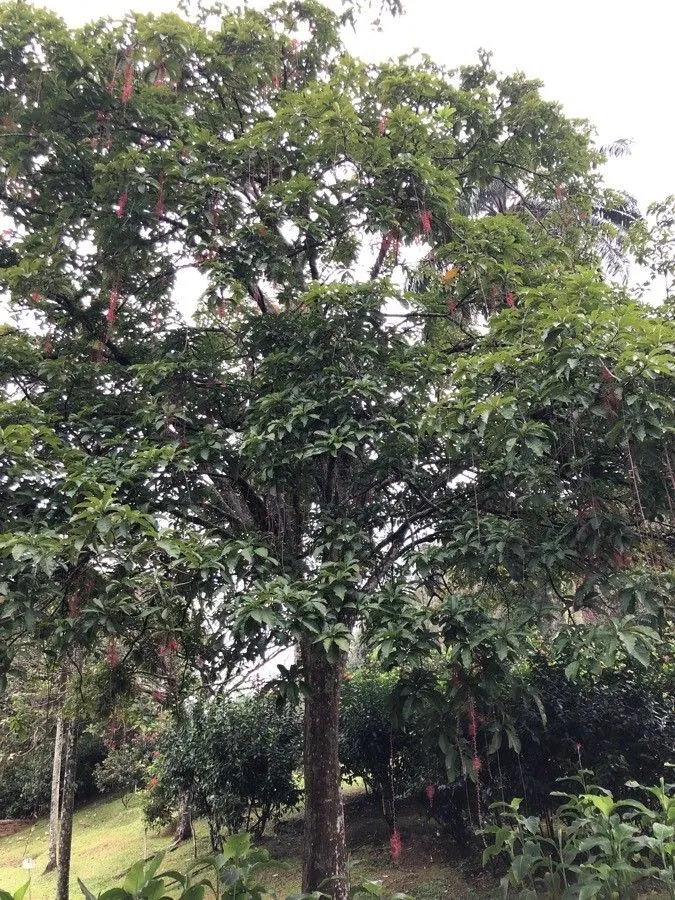
Author: (L.) Gaertn.
Bibliography: Fruct. Sem. Pl. 2: 97 (1791)
Year: 1791
Status: accepted
Rank: species
Genus: Barringtonia
Vegetable: False
Observations: Afghanistan to N. Australia
The Freshwater Mangrove, scientifically known as Barringtonia acutangula, is a fascinating and ecologically significant plant that belongs to the Lecythidaceae family. Described in the botanical literature “Fruct. Sem. Pl. 2: 97” in 1791 by the author (L.) Gaertn., this plant has a remarkable distribution range, extending from Afghanistan to Northern Australia.
The Freshwater Mangrove thrives in various freshwater habitats, including riverbanks, marshes, and swamps. Its presence is crucial in these ecosystems as it contributes to the stabilization of banks and the reduction of soil erosion. Furthermore, Barringtonia acutangula aids in maintaining water quality by filtering sediments and absorbing excess nutrients, thus supporting a diverse array of aquatic life.
This plant is distinguished by its unique morphological features, including its acutely angled branches, which is reflected in its scientific name “acutangula.” The leaves are typically elongated and can vary in color from bright green to a more subdued, darker shade, depending on the age of the foliage and environmental conditions.
One of the most striking characteristics of the Freshwater Mangrove is its flowering pattern. The blooms are often arranged in dense, cylindrical spikes and exhibit vibrant colors that attract various pollinators, including insects and birds. These flowers eventually give way to large, buoyant fruits that can disperse over long distances via water currents, aiding in the propagation of the species.
In addition to its ecological roles, Barringtonia acutangula holds cultural and economic significance in many regions. Various parts of the plant are traditionally used in folk medicine to treat ailments ranging from skin disorders to digestive issues. Additionally, its robust wood is sometimes utilized in construction and crafting.
Despite these benefits, the Freshwater Mangrove faces threats from habitat destruction and environmental changes. Conservation efforts are essential to protect this vital species and ensure that it continues to play its crucial role in freshwater ecosystems.
In summary, the Freshwater Mangrove, or Barringtonia acutangula, is not only a botanical wonder but also an integral part of the aquatic habitats from Afghanistan to Northern Australia. Its contributions to ecosystem stability, biodiversity, and human culture underscore the importance of preserving this remarkable species for future generations.
Eng: freshwater mangrove, itchytree, mango-pine
Khm: រាំងទឹក
En: Freshwater mangrove, Mango-pine, Itchytree, Hijal, ပတုက်၊တၞမ်, Indian oak, Attupezhu, Cheriyasamsthradhi, Small Indian Oak
As: হিজল
Bn: হিজল
My: ကျည်းပင်
Km: រាំងទឹក, Raing Toek
Ms: Pokok Gajah Beranak
Ml: ആറ്റുപേഴ്
Or: ହିଞ୍ଜଳ
Ta: செங்கடம்ப மரம்
Th: จิกน้ำ
Vi: Lộc vừng
Taken Jul 30, 2022 by John Tasirin (cc-by-sa)
Taken Dec 18, 2019 by Pierre Bonnet (cc-by-sa)
Taken Aug 16, 2021 by Janelle Jkhjung (cc-by-sa)
Taken Aug 16, 2021 by Janelle Jkhjung (cc-by-sa)
Taken Dec 18, 2019 by Pierre Bonnet (cc-by-sa)
Taken Oct 8, 2022 by Beatrice de Reynal (cc-by-sa)
Taken Jul 21, 2020 by bikash singh (cc-by-sa)
Taken Jul 27, 2021 by TeEphemeral (cc-by-sa)
Taken Jul 27, 2021 by TeEphemeral (cc-by-sa)
Taken Jul 17, 2022 by CaptainMarc hero1 (cc-by-sa)
Taken May 11, 2019 by Prakash Rudraraju (cc-by-sa)
Taken Feb 8, 2022 by Ivan Woodfield (cc-by-sa)
Taken Jul 21, 2020 by bikash singh (cc-by-sa)
Taken Jul 17, 2022 by CaptainMarc hero1 (cc-by-sa)
Taken Jul 17, 2022 by CaptainMarc hero1 (cc-by-sa)
© copyright of the Board of Trustees of the Royal Botanic Gardens, Kew.
© copyright of the Board of Trustees of the Royal Botanic Gardens, Kew.
© copyright of the Board of Trustees of the Royal Botanic Gardens, Kew.
Taken Dec 18, 2019 by Pierre Bonnet (cc-by-sa)
Taken Dec 18, 2019 by Pierre Bonnet (cc-by-sa)
Taken Dec 18, 2019 by Pierre Bonnet (cc-by-sa)
Taken Apr 15, 2022 by Nuong Nguyen (cc-by-sa)
Taken Oct 30, 2020 by Evie Rushforth (cc-by-sa)
Family: Myrtaceae Author: (F.Muell.) K.D.Hill & L.A.S.Johnson Bibliography: Telopea 6: 402 (1995) Year: 1995 Status:…
Family: Rubiaceae Author: Pierre ex A.Froehner Bibliography: Notizbl. Bot. Gart. Berlin-Dahlem 1: 237 (1897) Year:…
Family: Sapindaceae Author: Koidz. Bibliography: J. Coll. Sci. Imp. Univ. Tokyo 32(1): 38 (1911) Year:…
Family: Asteraceae Author: A.Gray Bibliography: Pacif. Railr. Rep.: 107 (1857) Year: 1857 Status: accepted Rank:…
Family: Fabaceae Author: Medik. Bibliography: Vorles. Churpfälz. Phys.-Ökon. Ges. 2: 398 (1787) Year: 1787 Status:…
Family: Aspleniaceae Author: (Cav.) Alston Bibliography: Bull. Misc. Inform. Kew 1932: 309 (1932) Year: 1932…